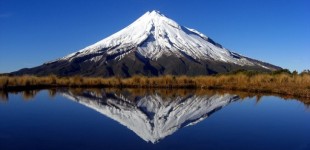Mount Taranaki

Taranaki is considered unusual in that it has experienced at least five of its major eruptions by the method of cone collapse. Few volcanoes have undergone more than one cone collapse. The vast volume of material involved in these collapses is reflected in the extensive ringplain surrounding the volcano. There is also evidence of lahars being a common result of eruption.
Much of the region is at risk from lahars, which have reached as far as the coast. A volcanic event is not necessary: even earthquakes combined with heavy rain or snow could dislodge vast quantities of unstable layers resting on steep slopes. Many farmers live in the paths of such possible destructive events.
Although volcanic eruptions are notoriously chaotic in their frequency, some scientists warn that a large eruption is „overdue“. Research from Massey University indicates that significant seismic activity is likely again in the next 50 years. Prevailing winds would probably blow ash east, covering much of the North Island, and disrupting air routes, power transmission lines and local water supplies.









One comment
I am a Costarrican ( a country of waterfalls and volcanes), I fall inlove with your volcano only because about your talent pictures. Thank you, now I want visit New Zeland more than ever.
Leave a Comment